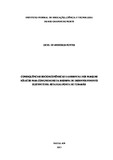Consequências socioeconômicas e ambiental dos parques eólicos para comunidades da Reserva de Desenvolvimento Sustentável Estadual Ponta do Tubarão

Visualizar/
Data
2017-07-28Autor
Pontes, Oziel de Medeiros
http://lattes.cnpq.br/6719731023007426
Metadado
Mostrar registro completoResumo
The present study aimed to analysis the socioeconomic and environmental consequences of
the wind farms installed in the Ponta do Tubarão State Sustainable Development Reserve
(RDSEPT), in the communities of Barreiras, Diogo Lopes and Sertãozinho, in the
municipality of Macau-RN, and Mangue Seco I, Mangue Seco II and Lagoa Doce, in the
municipality of Guamaré-RN. For this, secondary data were used: books, theses, periodicals
and simplified and primary reports: photographic records, digital images processing,
observations in loco and application of interviews, applied to individuals of Barreiras, Diogo
Lopes and Sertãozinho , 3% of the total population) and Mangue Seco I, Mangue Seco II and
Lagoa Doce (0.7% of the total population). The results showed negative socioeconomic and
environmental products of the wind farms, and the majority of the research public considered
bad (36%), regular (32%) and very bad (8%) the degree of importance of the parks, indicating
That 56% of respondents opted for the non-importance of wind farms to the community. This
discredit is due to the distance between the wind farms and the communities in question. In
addition, 76% of the interviewees do not know people who work in wind farms, which
evidenced the lack of interest, incentive and participation of public power and wind farms in
the construction of public policies, plans and projects that make local jobs viable. Similarly,
the survey revealed that there is virtually no absorption of the local labor force by wind farms,
just as there is no satisfaction of the majority of people interviewed with the environmental
effects of wind farms (53%). Among the environmental consequences of the installation of
wind farms for the communities studied are: deforestation (17%), visual pollution and
negative impacts on tourism (13%), blockade of people displacement (9%), Wind erosion and
interdunate pond landings (4%), reduction of fish volume (4%) and interruption of passage to
cattle (2%). Thus, the wind plants intalled in the referred communities and its surroundings
created negative economic, social and environmental products.



